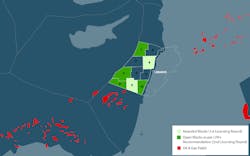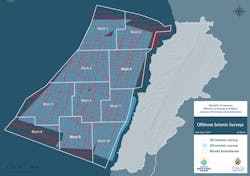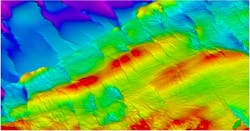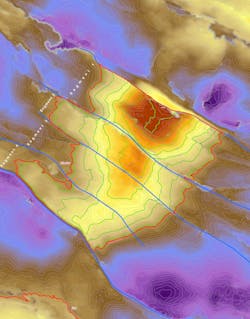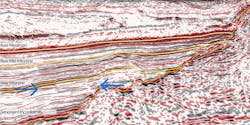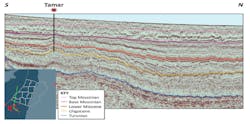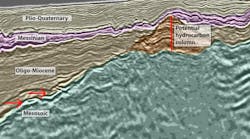Lebanon offering more offshore blocks as majors prepare to start drilling
Wissam Chbat, Wael Alkhatib, Jad Abi Khalil, Lebanese Petroleum Administration
Lebanon has opened more prospective acreage in the North Levant basin under the country’s Second Offshore Licensing Round. The selection process for the open blocks took notice of the priorities and goals of the international upstream oil and gas industry, in order to increase the probability of commercial discoveries.
The Lebanese basin is surrounded by proven hydrocarbon discoveries to the west and south, including the offshore gas fields Tamar, Leviathan, Aphrodite, Zohr, Calypso, Glaucus, and many others onshore to the east in the Palmyrides. So, the setting is in an area known to have favorable trap-reservoir-source rock combinations.
Total and partners Eni and Novatek are due to drill the first exploration well offshore Lebanon in 2019, on acreage awarded under the first offshore licensing round in 2017, with subsequent wells to follow in 2020, on respectively block 4 and block 9.
Lebanon’s offshore exclusive economic zone extends across 22,700 sq km (8,764 sq mi), with a total block area of 17,506 sq km (6,759 sq mi). Existing 2D and 3D seismic coverage amounts to respectively more than 14,000 km (8,700 mi) and over 15,000 sq km (5,791 sq mi), with near-complete 2D coverage on a 12 x 12-km (7.5 x 7.5-mi) grid and more than 80% coverage with 3D seismic data.
Post Permian-Triassic rifting, the Levant basin and adjacent nearby areas were a passive margin over a long geological time period, located along the south margin of the Tethys ocean. It is not surprising, therefore, that mapped prospects offshore Lebanon, based on the available seismic data, share the same trends as nearby discoveries.
Prospective targets
Various prospective offshore targets have been identified in siliciclastic, calciclastic to bioclastic lithologies. These targets are found in structural traps such as symmetrical anticlinal structures, simple three-way dip faulted anticlines and one-way fault closed structures; and in stratigraphic traps such as pinch-outs with associated direct hydrocarbon indicators.
The creaming curve of the Levant basin was flattening prior to Eni’s deepwater Zohr (carbonate) discovery offshore Egypt in 2015. This means that the Oligo-Miocene play sourced from Nile-derived deepwater fans is maturing, so, the size of the large discoveries in the areas being explored are declining, with remaining prospects in these areas expected to be smaller (and harder to find).
Two conclusions can be drawn. The first is that offshore Lebanon, representing the last undrilled acreage in the Levant basin, is an area that should be integrated into the exploration cycle. Secondly, the 250-300 m (820-984 ft) Early Miocene sand sequence proven in the South Levant platform thickens to more than 1 km in the North Levant basin, so this and the Oligo-Miocene succession offshore Lebanon represent strong targets for biogenic and thermogenic hydrocarbons. It should be noted that prior to the African plate’s collision with the Turkish fold and thrust belt, which effectively closed the passage between the Mediterranean and the Persian Gulf, the previously open seaway was subject to strong anti-clockwise contourite currents on the Mediterranean margin that would have de-silted the turbidite flow.
Another conclusion that can be drawn from the creaming curve is that the Zohr discovery was a paradigm shift in the exploration cycle. It was followed by Eni’s 2018 Calypso discovery and ExxonMobil’s more recent Glaucus discovery off southern Cyprus, both containing multiple tcf of gas. Seismic profiles offshore Lebanon indicate the presence of carbonate platforms and encouraging buildups of the same nature along the margin. Given the impact of recent giant carbonate discoveries in the Eastern Mediterranean, these carbonate build-ups constitute interesting targets for any future exploration activities.
Oil potential
Basin modeling shows a strong potential for a mixed biogenic and thermogenic system offshore Lebanon. Recent studies have revealed the potential for several gas-prone and oil-prone source rocks, from the Triassic to the Neogene, feeding into the North Levant basin.
The majority of the mapped prospects offshore Lebanon are generally assumed to be filled by dry biogenic gas, like the adjacent Leviathan, Zohr, and the many other discoveries in the Eastern Mediterranean. However, a credible oil play from an oil-prone source rock suggests there could also be large oil fields in the Lebanese offshore. Stratochem’s 3D modeling, coupled with more than 200 HC oil seeps observed across the North Levant basin on synthetic aperture radar images, indicate that this basin is also generating oil at present.
*Lebanon’s Ministry of Energy and Water has invited companies interested in participating in the licensing round to present their applications by 4 p.m. Jan. 31, 2020. Blocks 1, 2, 5, 8, and 10 are open for bidding. Pre-qualified applicants will be announced up to four weeks after the closing date for submissions, and the winners announced up to seven weeks after the closing date. •
